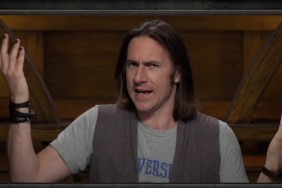Postcolonial Fantasy Island.
Even though it sounds like the subject of an interminably boring college lecture course, political geography is the “special sauce” that makes good open-world games tick. In titles like Grand Theft Auto: Vice City, Assassin’s Creed, and Far Cry 2, competing factions are divided by region as well as by socioeconomics and ideology.
[image1]As much as Just Cause 2 is all about big dumb fun and big explosions, it’s also surprisingly astute in how it describes the politics and geography of the third world. It’s part Rambo and part Postcolonial Studies 101. The three factions of the fictional Southeast Asian island nation of Panau present a shorthand version of the most fundamental political conflicts of the third world. The Roaches are the corrupt capitalist shipping magnates operating in the nation’s scattered cities. The Ular Boys are the cultural nationalists fighting on behalf of the rural populace and their traditional ways. And the Reapers are the radical ideologues fomenting revolution from Panau’s mountain caves and remote peaks.
Borrowing its plot from Dashiell Hammett’s frequently adapted novel Red Harvest, your job is to cause as much chaos as possible by ingratiating yourself with each of the three factions and setting them against one another in order to bring about the collapse of the island nation and bring down its corrupt dictator. The whys and wherefores become clearer as the game progresses, but it quickly becomes obvious that each faction is backed by a first-world nation—each with its own interest in seeing the nation destabilized.
In designing Just Cause 2, Avalanche Studios carefully hand-picked the best ideas and mechanics from a wide array of seminal open-world titles. The faction gameplay is borrowed from GTA: San Andreas. The tiered mission structure is borrowed from Saints Row. The parachute and grappling hook resemble the web traversal of Spider-Man 2. The political setting is similar to that of Mercenaries. The open-ended base attacks play out like those in Crackdown. The penchant for destruction is lifted from the Red Faction: Guerilla playbook. And so on. Yet for all its obvious influences, Just Cause 2 feels unique, and its many disparate elements fit seamlessly together.
Grounding the entire experience is the pairing of the grappling hook and parachute. They’re the peanut butter and jelly of Just Cause 2 and make the perfect bullet-riddled afternoon snack. The hook can be used to swing on, attach to, pull toward, tie to, hang from, and swing onto just about anything or anyone. The parachute can be combined with the hook to propel you across the landscape at high speeds, or it can be used on its own to glide gently to earth.
[image2]The hook and parachute mechanics are nearly flawless, particularly because even at their most broken, they’ll still surprise you in the best ways. Watching a car flip hundreds of feet into the air for no reason is damn fun even if it does mean that the physics are a bit messed up. Open-world games are notoriously buggy, but in Just Cause 2 those buggy moments are some of the most rewarding.
You’ll also quickly discover that traveling by parachute is faster and easier than traveling by most vehicles since their handling is subpar. The car physics are too stiff and steering is too sensitive. Planes aren’t bad, but helicopters can get downright frustrating especially when using a mounted machine gun to take down a target below you. Once I learned to stop worrying and love the parachute, I left the bad steering mechanics far behind me.
Once you stop screwing around with the grappling hook and parachute long enough, you’ll move on to the faction quests which generally involve doing short escort or sabotage missions for one of the factions. You also progress the game by destroying the nation’s infrastructure—water towers, generators, smoke stacks, radio towers, etc. Once you cause enough chaos, more missions will open up until one of the game’s few main story missions becomes available.
However, if you play Just Cause 2 just to move through the missions, you’ll get bored fast. There isn’t much variety in the faction quests and unlocking new ones generally just means doing the same old things in new places. Missions are at their best when things go horribly wrong and force you to improvise—or even better, when they lead you on a detour into the countryside where you discover a new bridge or building to jump off of.
[image3]But really, if you spend too much time worrying about the missions, you’re doing something very wrong. Like an island vacation, Just Cause 2 is meant to be savored and enjoyed. There’s no rush. There are literally thousands of towns, side quests, and hidden items to track down. Just cruising around in your parachute and using your grappling hook to propel you along is a joy in itself. The scenery is beautiful, the draw distance is impressive, and it all runs more smoothly than just about every other open-world game out there.
Sure, the missions get repetitive and the vehicle handling stinks, but for all that, Just Cause 2 is just plain fun. Since the granddaddy of the genre ditched its light-hearted roots in favor of heavy storytelling, there’s a big vacancy waiting to be filled by the next big contender to the sandbox crown. Despite its flaws (or perhaps because of them), Just Cause 2 is without a doubt at the front of the big dumb pack.
-
Stupid fun
-
Smart setting
-
Grappling hook + parachute = love
-
Big on content
-
Low on mission variety
-
Stiff vehicles










